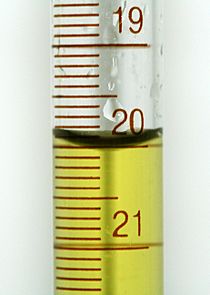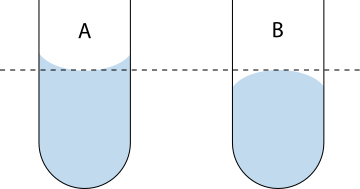Meniscus (liquid) facts for kids
Imagine looking at a glass of water. Have you ever noticed that the very top surface of the water isn't perfectly flat? It curves a little bit, either up or down, especially near the edges of the glass. This curve is called a meniscus. The word "meniscus" comes from a Greek word meaning "crescent," like the shape of the moon.
This curve happens because of how liquid particles interact with each other and with the container. It's all about something called surface tension.
Contents
Types of Menisci: Concave and Convex
There are two main types of menisci you might see:
Concave Meniscus

A concave meniscus looks like a little dip or a "U" shape. The liquid curves upwards at the edges, making the middle part lower. This happens when the liquid is more attracted to the material of the container than its own particles are to each other.
Think of it like this:
- Adhesion: This is how much the liquid "sticks" to the container.
- Cohesion: This is how much the liquid "sticks" to itself.
When adhesion is stronger than cohesion, the liquid tries to climb up the sides of the container. Water in a glass is a perfect example of a concave meniscus. Other liquids like sap, honey, and milk also form concave menisci in glass containers.
Convex Meniscus
A convex meniscus is the opposite. It looks like a little dome or a "hill" shape. The liquid curves downwards at the edges, making the middle part higher. This happens when the liquid's particles are much more attracted to each other (strong cohesion) than they are to the container (weak adhesion).
A common example is mercury in a glass tube. Mercury doesn't "stick" to glass very well, so its surface pulls away from the edges, forming a rounded top. You might see this in old-fashioned thermometers or barometers that used mercury.
Measuring Liquids Accurately
When you're measuring the amount of liquid in a container with a scale on the side, like a measuring cup or a burette in a science lab, the meniscus is very important. To get an accurate measurement, you need to read the scale at the correct part of the meniscus.
- For a concave meniscus (like water), you should read the measurement at the bottom of the curve.
- For a convex meniscus (like mercury), you should read the measurement at the top of the curve.
It's also important to make sure your eyes are level with the meniscus when you read it. This helps you avoid a mistake called parallax error, which can make your measurement seem higher or lower than it actually is.
Most measuring tools are made to account for the meniscus of a specific liquid, usually water.
Menisci and Capillary Action
Menisci are also part of a cool science trick called capillary action. This is when a liquid moves up or down a very narrow tube, called a capillary tube, all on its own.
If a liquid "wets" the tube (meaning it sticks to the tube, like water in a glass tube), it forms a concave meniscus. This curve helps pull the liquid up the tube. This is how plants drink water! Water travels from the roots all the way up to the leaves through tiny tubes inside the plant, thanks to capillary action and the menisci formed.
If a liquid doesn't "wet" the tube (like mercury in a glass tube), it forms a convex meniscus. This curve actually pushes the liquid down the tube.
See also
 In Spanish: Menisco (física) para niños
In Spanish: Menisco (física) para niños



